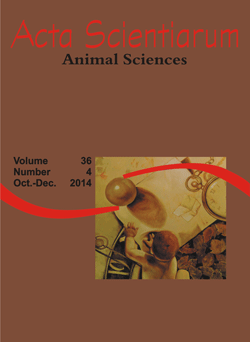<b>Sugar cane fresh or ensiled with or without bacterial additive in diets for dairy cows
Resumo
This study evaluated the effect of using fresh sugar cane, sugar cane silage with or without Lactobacillus buchneri, and burnt sugar cane silage with or without L. buchneri on ingestive behavior, nitrogen balance and synthesis of microbial nitrogen compounds of dairy cows. Five ¾ Holstein x Gir crossbred cows, assigned to a 5 x 5 Latin square design, were given diets with a 60:40 forage: concentrate ratio on a dry matter basis, to meet an average body weight of 550 kg and production of 15 kg of milk per day. The treatment with fresh sugar cane showed higher values (p < 0.05) for dry matter feed efficiency (3,133.3 vs 2,234.47 g DM h-1) and rumination (1,642.3 vs 1,222.93 g DM h-1) compared to the silages. There was a shorter total chewing time (58.7 vs 81.5 min. kg-1 DM) for fresh sugar cane when compared to silages without inoculum. The addition of microbial additive during ensiling of sugar cane did not alter (p > 0.05) the nitrogen intake and balance, but led to a greater (p < 0.05) synthesis of microbial nitrogen. Microbial efficiency was not affected (p > 0.05), and showed an average value of 204.32 g microbial crude protein kg-1 total digestible nutrients.
Downloads
DECLARAÇÃO DE ORIGINALIDADE E DIREITOS AUTORAIS
Declaro que o presente artigo é original, não tendo sido submetido à publicação em qualquer outro periódico nacional ou internacional, quer seja em parte ou em sua totalidade.
Os direitos autorais pertencem exclusivamente aos autores. Os direitos de licenciamento utilizados pelo periódico é a licença Creative Commons Attribution 4.0 (CC BY 4.0): são permitidos o compartilhamento (cópia e distribuição do material em qualqer meio ou formato) e adaptação (remix, transformação e criação de material a partir do conteúdo assim licenciado para quaisquer fins, inclusive comerciais.
Recomenda-se a leitura desse link para maiores informações sobre o tema: fornecimento de créditos e referências de forma correta, entre outros detalhes cruciais para uso adequado do material licenciado.








































